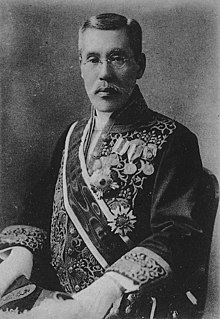Peace Preservation Law

The Public Security Preservation Laws were a series of laws enacted during the Empire of Japan. Collectively, the laws were designed to suppress political dissent.
Safety Preservation Law of 1894
The Safety Preservation Law of 1894 (保安条例, Hoan Jōrei) was an Imperial Ordinance issued on 25 December 1894, intended to suppress the Freedom and People's Rights Movement. It was the most drastic of the several laws enacted after 1875 to contain political opposition to the Meiji oligarchy. It imposed stringent restrictions on the press, public speeches and political meetings. Article Four of the Law authorized the chief of the Tokyo Metropolitan Police, with the approval of the Home Minister, to banish from Tokyo for three years anyone who was found to be inciting disturbances or scheming to disrupt public order within 7.5 miles of the Imperial Palace. Within three days of the law’s promulgation, 570 people prominent in the Freedom and People's Rights Movement (including future Tokyo governor Ozaki Yukio) were arrested and expelled. The Law was repealed in 1898, but was soon replaced by the more stringent Public Order and Police Law of 1900.
Public Order and Police Law of 1900

The Public Order and Police Law of 1900 (治安警察法, Chian Keisatsu Hō) was issued by the administration of Prime Minister Yamagata Aritomo specifically against the organized labor movements. In addition to restrictions on freedom of speech, assembly and association, it also specifically prohibited workers from organizing and going on strike. A provision banning women from political associations was deleted in 1922.
The provisions forbidding workers to organize and go on strike were deleted in 1926, although identical provisions were immediately added in an amendment to the Public Security Preservation Law of 1925.
However, as with the previous Public Safety Preservation Law of 1894, the Public Order and Police Law of 1900 was used to suppress political dissent. In 1920, professor Morito Tatsuo of Tokyo Imperial University was prosecuted for publishing an article critical of the anarchist Peter Kropotkin (in which Morito discussed anarchist ideas). Morito spent three months in jail on charges of treason. His case set a precedent in Japanese law that effectively criminalized the discussion of ideas. The government's clampdown on dissent further intensified after the 1921 assassination of Prime Minister Hara Takashi.
The Public Order and Police Law of 1900 was supplemented by the Public Security Preservation Law of 1925. It remained in effect until the end of World War II, when it was repealed by the American occupation authorities.
Public Security Preservation Law of 1925

The Public Security Preservation Law of 1925 (治安維持法, Chian Iji Hō) was enacted on 12 May 1925, under the administration of Katō Takaaki, specifically against socialism and communism.[1] It was one of the most significant laws of pre-war Japan.
The main force behind the law was Minister of Justice (and future Prime Minister) Hiranuma Kiichirō.
Anyone who has formed an association with the aim of altering the kokutai or the system of private property, and anyone who has joined such an association with full knowledge of its object, shall be liable to imprisonment with or without hard labour, for a term not exceeding ten years.
By using the highly vague and subjective term kokutai, the law attempted to blend politics and ethics, but the result was that any political opposition could be branded as "altering the kokutai". Thus the government had carte blanche to outlaw any form of dissent.
Renewed activity by underground Japan Communist Party in 1928 led to the March 15 Incident, in which police arrested more than 1,600 Communists and suspected Communists under the provisions of the Public Safety Preservation Law of 1925. The same year, the highly anti-Communist government of Tanaka Giichi pushed through an amendment to the law, raising the maximum penalty from ten years to death.
A "Thought Police" section, named the Tokkō, was formed within the Home Ministry, with branches all over Japan and in overseas locations with high concentrations of Japanese subjects to monitor activity by socialists and Communists. A Student Section was also established under the Ministry of Education to monitor university professors and students. Within the Ministry of Justice, special "Thought Prosecutors" (shiso kenji) were appointed to suppress "thought criminals", either through punishment or through "conversion" back to orthodoxy via reeducation.
In the 1930s, with Japan's increasing militarism and totalitarianism, dissent was tolerated less and less. In early February 1941, the Security Preservation Law of 1925 was completely re-written. Terms for people suspected of Communist sympathies became more severe, and for the first time religious organizations were included in the purview of the Thought Police. In addition, the appeals court for thought crimes was abolished, and the Ministry of Justice given the right to appoint defense attorneys in cases of thought crime. The new provisions became effective on 15 May 1941.
From 1925 through 1945, over 70,000 people were arrested under the provisions of the Public Security Preservation Law of 1925, but only about 10% reached trial, and the death penalty was imposed on only two offenders, spy Richard Sorge and his informant Ozaki Hotsumi. The Public Safety Preservation Law of 1925 was repealed after the end of World War II by the American occupation authorities.
References
- ^ James L. McClain, Japan: A Modern History p 390 ISBN 0-393-04156-5
- Mitchell, Richard H. Thought Control in Prewar Japan, Cornell University Press, 1976

